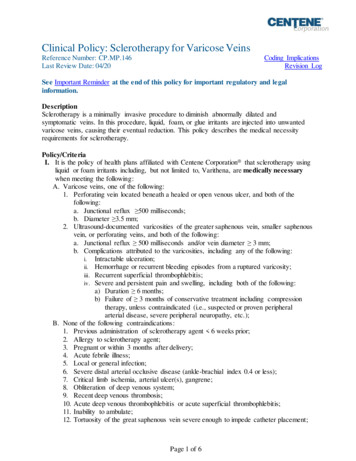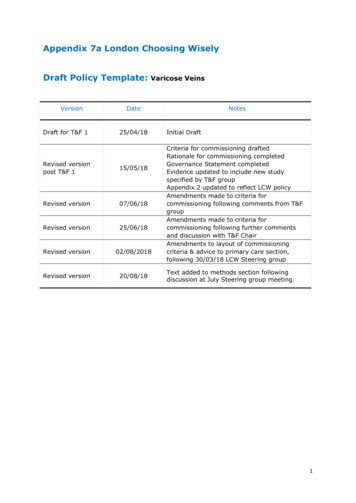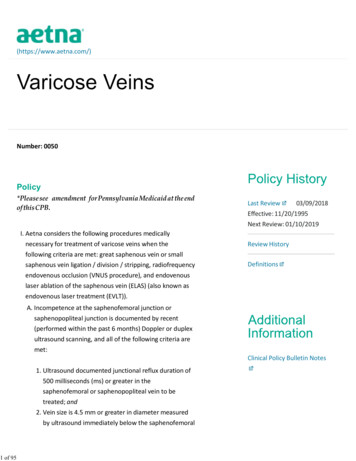
Transcription
Clinical Policy: Sclerotherapy for Varicose VeinsReference Number: CP.MP.146Last Review Date: 04/20Coding ImplicationsRevision LogSee Important Reminder at the end of this policy for important regulatory and legalinformation.DescriptionSclerotherapy is a minimally invasive procedure to diminish abnormally dilated andsymptomatic veins. In this procedure, liquid, foam, or glue irritants are injected into unwantedvaricose veins, causing their eventual reduction. This policy describes the medical necessityrequirements for sclerotherapy.Policy/CriteriaI. It is the policy of health plans affiliated with Centene Corporation that sclerotherapy usingliquid or foam irritants including, but not limited to, Varithena, are medically necessarywhen meeting the following:A. Varicose veins, one of the following:1. Perforating vein located beneath a healed or open venous ulcer, and both of thefollowing:a. Junctional reflux 500 milliseconds;b. Diameter 3.5 mm;2. Ultrasound-documented varicosities of the greater saphenous vein, smaller saphenousvein, or perforating veins, and both of the following:a. Junctional reflux 500 milliseconds and/or vein diameter 3 mm;b. Complications attributed to the varicosities, including any of the following:i. Intractable ulceration;ii. Hemorrhage or recurrent bleeding episodes from a ruptured varicosity;iii. Recurrent superficial thrombophlebitis;iv. Severe and persistent pain and swelling, including both of the following:a) Duration 6 months;b) Failure of 3 months of conservative treatment including compressiontherapy, unless contraindicated (i.e., suspected or proven peripheralarterial disease, severe peripheral neuropathy, etc.);B. None of the following contraindications:1. Previous administration of sclerotherapy agent 6 weeks prior;2. Allergy to sclerotherapy agent;3. Pregnant or within 3 months after delivery;4. Acute febrile illness;5. Local or general infection;6. Severe distal arterial occlusive disease (ankle-brachial index 0.4 or less);7. Critical limb ischemia, arterial ulcer(s), gangrene;8. Obliteration of deep venous system;9. Recent deep venous thrombosis;10. Acute deep venous thrombophlebitis or acute superficial thrombophlebitis;11. Inability to ambulate;12. Tortuosity of the great saphenous vein severe enough to impede catheter placement;Page 1 of 6
CLINICAL POLICYSclerotherapy for Varicose Veins13. Klippel-Trenaunay Syndrome or other congenital venous abnormalities.II. It is the policy of health plans affiliated with Centene Corporation that sclerotherapy is notmedically necessary for any of the following indications:A. Asymptomatic varicose veins1. Superficial reticular veins and/or telangiectasias;B. For the treatment of all other conditions than those specified above.III. It is the policy of health plans affiliated with Centene Corporation that cyanoacrylateadhesive (e.g. VenaSeal ) is considered investigational for the treatment of varicose veins.BackgroundVaricose veins can cause significant pain and discomfort, superficial thrombophlebitis, bleeding,and ulceration. As such, chronic venous insufficiency, including symptomatic varicosities, canhave a substantial negative impact on quality of life. 1 The pathophysiology that leads to thesevaricosities include inadequate muscle pump function, incompetent venous valves (reflux), andvenous obstruction.2According to clinical practice guidelines by the Society for Vascular Surgery and the AmericanVenous Form, sclerotherapy is a recommended treatment option for varicose veins. 4Sclerotherapy is a minimally invasive and cost effective procedure used to treat varicose veins.To perform this procedure, chemical irritants are injected into the unwanted vein to closevaricosities. Destruction of venous endothelial cells and the formation of a fibrotic obstructionfacilitate the venous closure due to injection of sclerosing agents. Liquid and foam sclerotherapyare the two predominant modalities for the introduction of sclerosing agents; examples of suchsclerosing agents include osmotic, alcohol and detergent agents. 3,4 A systemic review by Tisi etal evaluated 17 randomized controlled trials, and concluded that choice of sclerosing agents,dose, formulation (foam versus liquid), among other factors lack a significant effect on theefficacy of sclerotherapy for varicose veins.6Although cyanoacrylate adhesive has been introduced as an injectable agent for use insclerotherapy, future follow-up studies are needed to support the efficacy and safety in treatmentof varicose veins. The notable literature currently consists of a retrospective and a prospectivestudy without randomization. 7,9 Further long-term studies are needed to support the use ofcyanoacrylate prior to integration into medical necessity guidelines.There is no consensus in the literature regarding the optimal number of sclerotherapy treatmentsrequired to reduce the symptoms associated with varicose veins. Treatment of symptomaticrecurrent varicose veins should be performed after careful evaluation of the patient with duplexscanning to assess the etiology, source, type, and extent of recurrent varicose veins. 4Retreatment of any single area should be delayed for 6–8 weeks to allow the treated veins to healfully; in this manner, unnecessary retreatment of an effectively sclerosed vein is not performed.12Coding ImplicationsThis clinical policy references Current Procedural Terminology (CPT ). CPT is a registeredtrademark of the American Medical Association. All CPT codes and descriptions are copyrightedPage 2 of 6
CLINICAL POLICYSclerotherapy for Varicose Veins2020, American Medical Association. All rights reserved. CPT codes and CPT descriptions arefrom the current manuals and those included herein are not intended to be all-inclusive and areincluded for informational purposes only. Codes referenced in this clinical policy are forinformational purposes only. Inclusion or exclusion of any codes does not guarantee coverage.Providers should reference the most up-to-date sources of professional coding guidance prior tothe submission of claims for reimbursement of covered services.Codes that support medical necessityCPT DescriptionCodes36465Injection of non-compounded foam sclerosant with ultrasound compressionmaneuvers to guide dispersion of the injectate, inclusive of all imagingguidance and monitoring; single incompetent extremity truncal vein (eg, greatsaphenous vein, accessory saphenous vein)36466Injection of non-compounded foam sclerosant with ultrasound compressionmaneuvers to guide dispersion of the injectate, inclusive of all imagingguidance and monitoring; multiple incompetent truncal veins (eg, greatsaphenous vein, accessory saphenous vein), same leg.36470Injection of sclerosant; single incompetent vein (other than telangiectasia)36471Injection of sclerosant; multiple incompetent veins (other than telangiectasia),same legCodes that do not support medical necessityCPT DescriptionCodes36482Endovenous ablation therapy of incompetent vein, extremity, by transcatheterdelivery of a chemical adhesive (eg, cyanoacrylate) remote from the accesssite, inclusive of all imaging guidance and monitoring, percutaneous; first veintreated36483Endovenous ablation therapy of incompetent vein, extremity, by transcatheterdelivery of a chemical adhesive (eg, cyanoacrylate) remote from the accesssite, inclusive of all imaging guidance and monitoring, percutaneous;subsequent vein(s) treated in a single extremity, each through separate accesssites (List separately in addition to code for primary procedure)Reviews, Revisions, and ApprovalsDateNew policyReferences reviewed and updated. CPT codes updated.Updated description to include mention of glue irritants. Addedcontraindication for previous administration of sclerotherapy andsyndrome/congenital abnormalities. In “I.” added stipulation that liquid orfoam agents to be used in sclerotherapy. Added statement thatcyanoacrylate adhesive is investigational with supporting backgroundinformation. In I.A.2.d. removed failure of 3 weeks prescription dose05/1704/1803/19Page 3 of 6ApprovalDate06/1704/1804/19
CLINICAL POLICYSclerotherapy for Varicose VeinsReviews, Revisions, and Approvalsanalgesic medications for pain and added failure of 3 months ofconservative treatment including compression therapy unlesscontraindicated.Added VenaSeal as an example of cyanoacrylate in the investigationalstatement in section III. Added codes for cyanoacrylate to a new table ofcodes that do not support medical necessity.Added perforating veins under a current or healed ulcer as an indication;Edited previous criteria for saphenous veins to apply to saphenous veins orperforating veins. Specialist review.Changed requirement for junctional reflux of greater saphenous veins to 3mm, from 2.5 mm. Background updated with no impact on criteria.References reviewed and updated. Revised policy statement addingVarithena as an example of a foam ences1. Behravesh, Sasan, et al. "Venous malformations: clinical diagnosis and treatment."Cardiovascular Diagnosis and Therapy 6.6 (2016): 557-569.2. Scovell S, Alguire PC. Overview and management of lower extremity chronic venousdisease. In: UpToDate, Eidt JF, Mills JF (Ed), UpToDate, Waltham, MA. Accessed 3/18/20.3. Scovell, S. Liquid, foam, and glue sclerotherapy techniques for the treatment of lowerextremity veins. In: UpToDate, Eidt JF, Mills JL, Dover JS. (Eds), UpToDate, Waltham,MA. Accessed 3/19/20.4. Gloviczki P, et al; The care of patients with varicose veins and associated chronic venousdiseases: Clinical practice guidelines of the Society for Vascular Surgery and the AmericanVenous Forum; J Vasc Surg 2011;53:2S-48S5. Jose I. Almeida, MD, et al. Use of the Clinical, Etiologic, Anatomic, and Pathophysiologicclassification and Venous Clinical Severity Score to establish a treatment plan for chronicvenous disorders. J Vasc Surg: Venous and Lym Dis 2015;3:456-60.6. Weiss, Margaret A., et al. "Consensus for sclerotherapy." Dermatologic Surgery 40.12(2014): 1309-1318.7. Tisi PV, Beverley C, Rees A. Injection sclerotherapy for varicose veins. Cochrane DatabaseSyst Rev 2006:CD001732.8. Koramaz, MD, Ismail, et al. Ablation of the great saphenous vein with nontumescentn-butyl cyanoacrylate versus endovenous laser therapy. Journal of Vascular Surgery:Venous and Lymphatic Disorders, Volume 5. Number 2.9. Kaygin MA, Halici U. Evaluation of liquid or foam sclerotherapy in small varicose veins(ceap c1) with venous clinical severity score. Revista Da Associacao Medica Brasileira(1992). 2018;64(12):1117-1121. doi:10.1590/1806-9282.64.12.1117.10. Koramaz İ, El Kılıç H, Gökalp F, et al. Ablation of the great saphenous vein withnontumescent n-butyl cyanoacrylate versus endovenous laser therapy. J Vasc Surg VenousLymphat Disord. 2017 Mar;5(2):210-215. doi: 10.1016/j.jvsv.2016.09.007.11. Lim CS, Davies AH. Graduated compression stockings. CMAJ. age 4 of 6
CLINICAL POLICYSclerotherapy for Varicose Veins12. Worthington-Kirsch RL. Injection Sclerotherapy. Semin Intervent Radiol. 2005Sep;22(3):209-17. doi: 10.1055/s-2005-921954.13. Hayes Health Technology Assessment. Cyanoacrylate Embolization (VenaSeal ClosureSystem) for the Treatment of Varicose Veins. October 31, 2019. Accessed March, 27, 2020Important ReminderThis clinical policy has been developed by appropriately experienced and licensed health careprofessionals based on a review and consideration of currently available generally acceptedstandards of medical practice; peer-reviewed medical literature; government agency/programapproval status; evidence-based guidelines and positions of leading national health professionalorganizations; views of physicians practicing in relevant clinical areas affected by this clinicalpolicy; and other available clinical information. The Health Plan makes no representations andaccepts no liability with respect to the content of any external information used or relied upon indeveloping this clinical policy. This clinical policy is consistent with standards of medicalpractice current at the time that this clinical policy was approved. “Health Plan” means a healthplan that has adopted this clinical policy and that is operated or administered, in whole or in part,by Centene Management Company, LLC, or any of such health plan’s affiliates, as applicable.The purpose of this clinical policy is to provide a guide to medical necessity, which is acomponent of the guidelines used to assist in making coverage decisions and administeringbenefits. It does not constitute a contract or guarantee regarding payment or results. Coveragedecisions and the administration of benefits are subject to all terms, conditions, exclusions andlimitations of the coverage documents (e.g., evidence of coverage, certificate of coverage, policy,contract of insurance, etc.), as well as to state and federal requirements and applicable HealthPlan-level administrative policies and procedures.This clinical policy is effective as of the date determined by the Health Plan. The date of postingmay not be the effective date of this clinical policy. This clinical policy may be subject toapplicable legal and regulatory requirements relating to provider notification. If there is adiscrepancy between the effective date of this clinical policy and any applicable legal orregulatory requirement, the requirements of law and regulation shall govern. The Health Planretains the right to change, amend or withdraw this clinical policy, and additional clinicalpolicies may be developed and adopted as needed, at any time.This clinical policy does not constitute medical advice, medical treatment or medical care. It isnot intended to dictate to providers how to practice medicine. Providers are expected to exerciseprofessional medical judgment in providing the most appropriate care, and are solely responsiblefor the medical advice and treatment of members. This clinical policy is not intended torecommend treatment for members. Members should consult with their treating physician inconnection with diagnosis and treatment decisions.Providers referred to in this clinical policy are independent contractors who exercise independentjudgment and over whom the Health Plan has no control or right of control. Providers are notagents or employees of the Health Plan.Page 5 of 6
CLINICAL POLICYSclerotherapy for Varicose VeinsThis clinical policy is the property of the Health Plan. Unauthorized copying, use, anddistribution of this clinical policy or any information contained herein are strictly prohibited.Providers, members and their representatives are bound to the terms and conditions expressedherein through the terms of their contracts. Where no such contract exists, providers, membersand their representatives agree to be bound by such terms and conditions by providing services tomembers and/or submitting claims for payment for such services.Note: For Medicaid members, when state Medicaid coverage provisions conflict with thecoverage provisions in this clinical policy, state Medicaid coverage provisions take precedence.Please refer to the state Medicaid manual for any coverage provisions pertaining to this clinicalpolicy.Note: For Medicare members, to ensure consistency with the Medicare National CoverageDeterminations (NCD) and Local Coverage Determinations (LCD), all applicable NCDs, LCDs,and Medicare Coverage Articles should be reviewed prior to applying the criteria set forth in thisclinical policy. Refer to the CMS website at http://www.cms.gov for additional information. 2017 Centene Corporation. All rights reserved. All materials are exclusively owned byCentene Corporation and are protected by United States copyright law and internationalcopyright law. No part of this publication may be reproduced, copied, modified, distributed,displayed, stored in a retrieval system, transmitted in any form or by any means, or otherwisepublished without the prior written permission of Centene Corporation. You may not alter orremove any trademark, copyright or other notice contained herein. Centene and CenteneCorporation are registered trademarks exclusively owned by Centene Corporation.Page 6 of 6
1. Perforating vein located beneath a healed or open venous ulcer, and both of the following: a. Junctional reflux 500 milliseconds; b. Diameter 3.5 mm; 2. Ultrasound-documented varicosities of the greater saphenous vein, smaller saphenous vein, or perforating veins, and both of the following: a.










